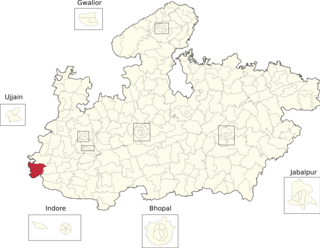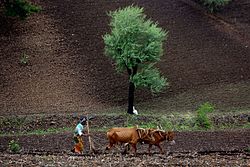
Jhabua is a town and a municipality in Jhabua district in the Indian state of Madhya Pradesh. It is the administrative headquarters of Jhabua District.

Ratlam is a city in the northwestern part of the Malwa region in Madhya Pradesh state of India. The city of Ratlam lies 480 metres (1,570 ft) above sea level. It is the administrative headquarters of Ratlam district, which was created in 1947 after the independence of India. It is located 294 kilometres west of the state capital Bhopal.

The Bhil languages are a group of lects spoken by the Bhil that are classified as dialects of Indo-Aryan languages such as Gujarati and Rajasthani. They are spoken by around 10.4 million Bhils in western and central India as of 2011 and constitute the primary languages of the southern Aravalli Range in Rajasthan and the western Satpura Range in Madhya Pradesh, northwestern Maharashtra, and southern Gujarat.

Khargone district, formerly known as West Nimar district, is a district of Madhya Pradesh state in central India. The district lies in the Nimar region and is part of the Indore Division. The district headquarters is the city of Khargone, which lies south of the Indore metropolis, the headquarters of Indore district.

Alirajpur is a city in the Alirajpur tehsil in Alirajpur district in the state of Madhya Pradesh, India.

Dahod district is a district of Gujarat state in western India. This largely tribal district is mostly covered by forests and hills.

Barwani district is one of the districts of Madhya Pradesh state of India. The administrative headquarters of the district is at Barwani.

Dhar district is a district of Madhya Pradesh state in central India. The historic town of Dhar is administrative headquarters of the district.

Ratlam District is a district of Madhya Pradesh state in central India. The town of Ratlam is administrative headquarters of the district.

Damoh District is a district of Madhya Pradesh state in central India. The town of Damoh is the district headquarters. The district is part of the Sagar Division.

Khandwa district, formerly known as the East Nimar district, is a district of the Madhya Pradesh state in central India. The city of Khandwa is the administrative headquarters of the district. Other notable towns in the district include Mundi, Harsud, Punasa, Pandhana and Omkareshwar.

Sehore District is a district of Madhya Pradesh state in central India. The town of Sehore is the district headquarters. The district is part of Bhopal Division.
Meghnagar is a City Council and a Tehsil Headquarter in Jhabua district in the India state of Madhya Pradesh.
Petlawad is a town and a Nagar Panchayat in the Jhabua district in the Indian state of Madhya Pradesh, formerly the Central Provinces. The town received nationwide media coverage on 12 September 2015 when an explosion killed approximately 100 people and injured over 150 people in the Petlawad explosion.
Thandla is a town in Thandla Tehsil in Jhabua District of Madhya Pradesh, India. It belongs to Indore Division. It is located 30 km north of the District headquarters of Jhabua. It is a Tehsil headquarter. Thandla was named after Bhil Sardar Thana.

Alirajpur is one of the 55 districts of Madhya Pradesh state in India. It was created from Alirajpur, Jobat and Bhabra tehsils of the former Jhabua district on 17 May 2008. It is the least literate district in India as per Census 2011. Alirajpur is the administrative headquarters of the district. The district occupies an area of 2,165.24 square kilometres (836.00 sq mi), and at the 2011 census had a population of 728,999. It includes the city of Alirajpur.

Alirajpur is one of the 230 Vidhan Sabha constituencies of Madhya Pradesh state in central India. This constituency came into existence in 1951, as one of the 79 Vidhan Sabha constituencies of the erstwhile Madhya Bharat state. This constituency is reserved for the candidates belonging to the Scheduled tribes since its inception.

Jobat is one of the 230 Vidhan Sabha constituencies of Madhya Pradesh state in central India. This constituency came into existence in 1951, as one of the 79 Vidhan Sabha constituencies of the erstwhile Madhya Bharat state. This constituency is reserved for the candidates belonging to the Scheduled tribes since its inception.

Sailana is one of the 230 Vidhan Sabha constituencies of Madhya Pradesh state in central India. This constituency came into existence in 1951 as one of the 79 Vidhan Sabha constituencies of the erstwhile Madhya Bharat state. It was abolished in 1956 but again came into existence in 1961. This constituency is reserved for the candidates belonging to the Scheduled tribes since its inception.
Meghnagar railway station is a small railway station in Jhabua district, Madhya Pradesh. Its code is MGN. It serves Meghnagar city. The station consists of three platforms. The platforms are not well sheltered. It lacks many facilities including water and sanitation.


















